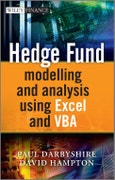The book provides hands-on coverage of the visual and theoretical methods for measuring and modelling hedge fund performance with an emphasis on risk-adjusted performance metrics and techniques. A range of sophisticated risk analysis models and risk management strategies are also described in detail. Throughout, coverage is supplemented with helpful skill building exercises and worked examples in Excel and VBA.
A comprehensive course in hedge fund modelling and analysis, this book arms you with the knowledge and tools required to effectively manage your risks and to optimise the return profile of your investment style.
Table of Contents
Preface xi1 The Hedge Fund Industry 1
1.1 What Are Hedge Funds? 1
1.2 The Structure of a Hedge Fund 4
1.2.1 Fund Administrators 5
1.2.2 Prime Brokers 5
1.2.3 Custodian, Auditors and Legal 6
1.3 The Global Hedge Fund Industry 7
1.3.1 North America 8
1.3.2 Europe 10
1.3.3 Asia 11
1.4 Specialist Investment Techniques 12
1.4.1 Short Selling 12
1.4.2 Leverage 14
1.4.3 Liquidity 15
1.5 New Developments for Hedge Funds 16
1.5.1 UCITS III Hedge Funds 16
1.5.2 The European Passport 19
1.5.3 Restrictions on Short Selling 20
2 Major Hedge Fund Strategies 23
2.1 Single- and Multi-Strategy Hedge Funds 23
2.2 Fund of Hedge Funds 25
2.3 Hedge Fund Strategies 27
2.3.1 Tactical Strategies 28
2.3.1.1 Global Macro 28
2.3.1.2 Managed Futures 31
2.3.1.3 Long/Short Equity 36
2.3.1.4 Pairs Trading 38
2.3.2 Event-Driven 42
2.3.2.1 Distressed Securities 42
2.3.2.2 Merger Arbitrage 46
2.3.3 Relative Value 49
2.3.3.1 Equity Market Neutral 49
2.3.3.2 Convertible Arbitrage 50
2.3.3.3 Fixed Income Arbitrage 54
2.3.3.3.1 Capital Structure Arbitrage 56
2.3.3.3.2 Swap-Spread Arbitrage 57
2.3.3.3.3 Yield Curve Arbitrage 58
3 Hedge Fund Data Sources 61
3.1 Hedge Fund Databases 61
3.2 Major Hedge Fund Indices 65
3.2.1 Non-investable and Investable Indices 66
3.2.2 Dow Jones Credit Suisse Hedge Fund Indexes 68
3.2.2.1 Liquid Alternative Betas 70
3.2.3 Hedge Fund Research 73
3.2.4 HedgeFund.net 77
3.2.5 FTSE Hedge 77
3.2.5.1 FTSE Hedge Momentum Index 78
3.2.6 Greenwich Alternative Investments 79
3.2.6.1 GAI Investable Indices 80
3.2.7 Morningstar Alternative Investment Center 83
3.2.7.1 MSCI Hedge Fund Classification
Standard 83
3.2.7.2 MSCI Investable Indices 85
3.2.3 Database and Index Biases 88
3.3.1 Survivorship Bias 89
3.3.2 Instant History Bias 90
3.4 Benchmarking 91
3.4.1 Tracking Error 92
Appendix A: Weighting Schemes 95
4 Statistical Analysis 99
4.1 Basic Performance Plots 99
4.1.1 Value Added Monthly Index 99
4.1.2 Histograms 102
4.2 Probability Distributions 105
4.2.1 Populations and Samples 106
4.3 Probability Density Function 107
4.4 Cumulative Distribution Function 108
4.5 The Normal Distribution 109
4.5.1 Standard Normal Distribution 110
4.6 Visual Tests for Normality 111
4.6.1 Inspection 111
4.6.2 Normal Q-Q Plot 112
4.7 Moments of a Distribution 114
4.7.1 Mean and Standard Deviation 114
4.7.2 Skewness 117
4.7.3 Excess Kurtosis 119
4.7.4 Data Analysis Tool: Descriptive
Statistics 120
4.8 Geometric Brownian Motion 122
4.8.1 Uniform Random Numbers 125
4.9 Covariance and Correlation 126
4.10 Regression Analysis 131
4.10.1 Ordinary Least Squares 131
4.10.1.1 Coefficient of Determination 133
4.10.1.2 Residual Plots 134
4.10.1.3 Jarque–Bera Normality Test 135
4.10.1.4 Data Analysis Tool: Regression 138
4.11 Portfolio Theory 142
4.11.1 Mean–Variance Analysis 142
4.11.2 Solver: Portfolio Optimisation 145
4.11.3 Efficient Portfolios 148
5 Risk-Adjusted Return Metrics 151
5.1 The Intuition behind Risk-Adjusted Returns 152
5.1.1 Risk-Adjusted Returns 154
5.2 Common Risk-Adjusted Performance Ratios 157
5.2.1 The Sharpe Ratio 160
5.2.2 The Modified Sharpe Ratio 162
5.2.3 The Sortino Ratio 163
5.2.4 The Drawdown Ratio 167
5.3 Common Performance Measures in the Presence of a
Market Benchmark 170
5.3.1 The Information Ratio 172
5.3.2 The M-Squared Metric 173
5.3.3 The Treynor Ratio 174
5.3.4 Jensen’s Alpha 178
5.4 The Omega Ratio 181
6 Asset Pricing Models 185
6.1 The Risk-Adjusted Two-Moment Capital
Asset Pricing Model 185
6.1.1 Interpreting H 189
6.1.2 Static Alpha Analysis 191
6.1.3 Dynamic Rolling Alpha Analysis 193
6.2 Multi-factor Models 195
6.3 The Choice of Factors 196
6.3.1 A Multi-Factor Framework for a
Risk-Adjusted Hedge Fund Alpha
League Table 202
6.3.2 Alpha and Beta Separation 208
6.4 Dynamic Style Based Return Analysis 210
6.5 The Markowitz Risk-Adjusted Evaluation Method 214
7 Hedge Fund Market Risk Management 223
7.1 Value-at-Risk 223
7.2 Traditional Measures 226
7.2.1 Historical Simulation 226
7.2.2 Parametric Method 229
7.2.3 Monte Carlo Simulation 230
7.3 Modified VaR 233
7.4 Expected Shortfall 236
7.5 Extreme Value Theory 239
7.5.1 Block Maxima 240
7.5.2 Peaks over Threshold 241
References 245
Important Legal Information 249
Index 251








